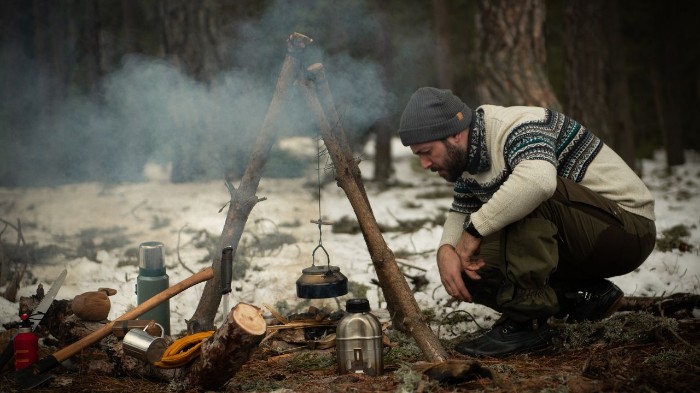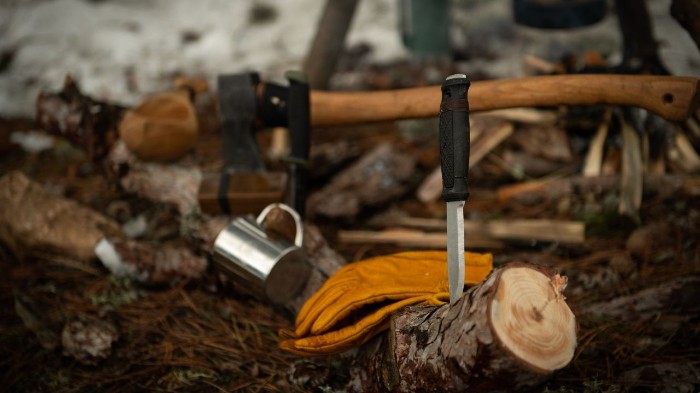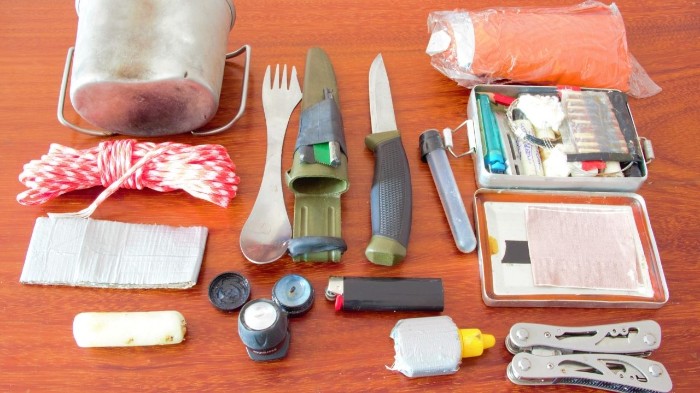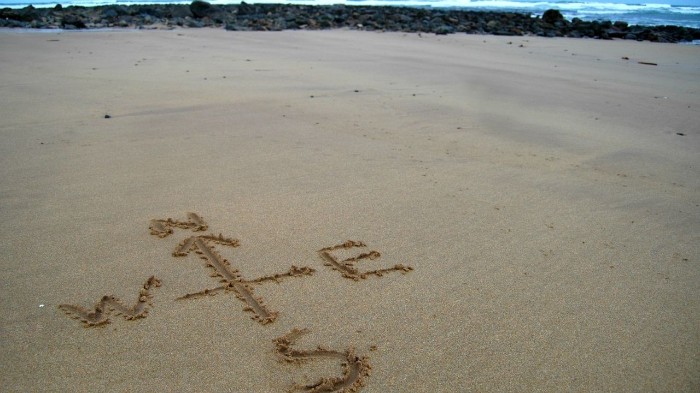Have you ever found yourself in the middle of nature, surrounded by wilderness and feeling completely unprepared to face it? If so, you're not alone. Many people assume survival is an innate skill but that's far from the truth. Surviving in the wilderness requires proper preparation and knowledge of survival skills, such as bushcraft.
8 basic survival skills you can learn in your own backyard
With the right preparation, you can be completely confident while exploring in the wilderness. To ensure your safety and success when out in nature, it is essential to learn eight basic survival skills before venturing into wild terrain. With these tools under your belt, you will feel ready to handle any situation that may arise!

How to practice water filtering?
Get dirty water out of the nearest waterways. Use a filter to filter. Make the filters from diy bottles. Compare results by observing the clarity of the resultant water.
Lifestraw Water Filter
The Lidestraw is an easy-to-use, portable survival tool that removes 99.9999% of waterborne bacteria and parasites.

Firestarting
Starting fires is a very important survival skill that everyone should be able to use at all times. It doesn't require a lighter. You can practice by using friction techniques such as the bow drill, flint and steel and more. Practice building a fire with different types of fuel sources like tinder, kindling and logs.
Firestarting is a crucial survival skill that everyone needs to be able to master, especially when in the wilderness. It can be a daunting task without the use of modern tools, such as lighters, but with the right knowledge and preparation it is possible to start a fire without these devices.
Starting a fire in the wilderness can be an easy task with the right kind of knowledge and resources. To begin, you will need some kind of heat source such as matches or a lighter, tinder to catch the spark, and wood to fuel the flame.
First, you will want to find a dry spot on the ground with no brush nearby that could catch fire once lit. This can be difficult in damp climates but still possible with certain techniques.
Next, gather your tinder such as dry leaves, small twigs and other highly flammable items that will quickly ignite upon contact from your heat source. Arrange these items into a pile of roughly three inches thick. Cover this pile of tinder with larger pieces of wood to form a tipi-like structure around it.
Now for the actual starting process - strike your matches or use your lighter to ignite the tinder at the very center of the structure where there is plenty of oxygen for it to burn properly. Once sparked up make sure to blow on it gently yet positively so that it burns better and larger pieces of wood can be added gradually until your desired size is achieved.
Lastly, keep adding more fuel in whatever form is available (grass, dried bark etc.), always ensuring that enough oxygen is present not just for initial ignition but also for proper burning so use methods like creating ‘chimneys’ in between logs if needed.. With all this being said, following these steps should have given you a nice roaring campfire by now!

Basic First Aid Skills for Survival
It is essential to have basic First Aid skills when travelling in the wilderness, or even just living life in general. It may be necessary to help a companion or even oneself if an injury were to occur and there is no medical professional around.
First Aid can range from minor cuts and scrapes all the way up to more serious injuries such as broken bones or head trauma. However, the most important aspect of First Aid is being able to identify when someone needs medical attention and getting them help as quickly as possible.
When it comes to minor cuts and scrapes, you should always make sure that you are carrying a basic survival kit which includes items like gauze, bandages and antiseptics. These items can be used to clean and protect the wound, help stop any bleeding and reduce the risk of infection.
In more serious cases, it is important to know how to perform CPR and what type of splinting material you should use depending on the injury. You should also make sure that you are familiar with common medical symbols and can easily recognize signs of shock or heat stroke.
No matter the situation, having a basic understanding of First Aid is vital to survival in any environment. By being prepared and knowing how to respond in an emergency situation you increase your chances of survival and help ensure that everyone around you is safe. So make sure to take the time to learn the basics of First Aid and always carry a survival kit with you when travelling in the wilderness. Doing so could save your life or someone else’s!

Building a shelter
Finding shelter is one of the most essential survival skills and can be the difference between life and death in a survival situation. It is important to be able to locate, construct, and maintain a shelter that will protect you from environmental hazards such as extreme temperatures, wind, rain, snow, and other inclement weather.
To best hone your shelter-building skills, why not practice in the comfort of your own backyard? Depending on the terrain and season, there are endless possibilities for creating makeshift shelters. Begin by laying down a flat surface or blanket as a foundation before gradually working up to tying sticks together into teepee formations. With enough practice and patience, you will soon be an expert at building fortresses!
Snow caves are a great survival skill to have when living in snowy terrain. In the event of an emergency, they provide insulation from the cold, blocking out wind and trapping body heat inside. Building a snow cave is no easy task, but with some practice and preparation it can be done with relative ease.
These shelter building tips are a great start to helping you survive in any environment. Whether you are in the backyard or deep in the back country, understanding how to build a shelter is an essential survival skill that can be applied anywhere and anytime. With enough knowledge of survival skills and preparation you should have no fear when it comes to facing Mother Nature!

Outdoor cooking
Learning to start a fire is only the first step. Next you need to learn the basics of outdoor cooking by using the fire, or other survival devices you have with you.
Whether your survival expertise is in the backcountry of nature or a survival situation in an urban jungle,you can easily master cooking techniques that will help you survive.
The first thing to keep in mind when it comes to outdoor cooking is safety and hygiene. Always ensure the cooking surface is clean and free from debris that may cause contamination.
Next, choose the type of survival device you will use to cook with – these can be anything from a campfire grill, tinfoil packets, or even an improvised stove made out of stones.
Once your survival device and ingredients are ready, it’s time to start cooking. With some practice, you can become a master of survival cuisine!
Whether it be boiling water for coffee or creating a hearty stew with vegetables and wild game, being able to cook in the wilderness is more than just survival knowledge – it’s also enjoyable.
These survival skills make sure you have the sustenance and energy you need to stay alive in survival situations, no matter where they occur.
So don’t be afraid to explore different survival cooking techniques – you never know when your survival skills will come in handy!

Making a Weapon
If you are looking for a way to keep predators away from your property, nothing can compare to the power of a firearm.
However, if it is not easily accessible, slingshots should definitely be considered as an alternative. With just two basic items needed and minimal effort involved in assembling them, they could prove invaluable when trying to protect yourself and your family.
Other weapons that can be made in an emergency survival situation include a bow, spear and even a blow gun. All of these require some level of skill and practice to perfect but they can be effective in protecting yourself against unwelcome animals or intruders.
When it comes to survival, having the right tools and knowledge is key. Learning how to make weapons in an emergency situation could be invaluable and potentially

Knot-Tying
There are lots of scenarios when one must use an excellent, sturdy knot. Although there are lots of knots you can learn, only one is necessary. Our guide includes every knot needed for survival; although, learning two or three is a good way to get started before you start learning another skill.
The most important survival knot is the square knot. This is a very versatile and strong knot that can be used to tie many different objects together or just hold something in place.
When practicing, start with some rope, string, or twine to get familiar with how it works. When you're comfortable with tying this knot, move on to some paracord or rope, as they are typically more difficult to tie.
Once you have mastered the square knot, try out other survival knots such as the bowline knot and clove hitch knot. They can be used in various survival scenarios, so it’s important that you know how to use them.
Knowing how to tie survival knots can be a valuable tool in an emergency survival situation. With some practice, you can quickly become an expert on survival knot-tying and use your skills to help yourself and others in need.
Off the Grid Communication
Getting a license for HAM radio is not only important, it's necessary! But even if your don't have one, you can still use these radios in an emergency. There are other ways to stay informed during an emergency as well — TV and the Internet are great sources of information, but there’s also something that should never be overlooked: handcranked emergency radios. Learn more about how ham radios are used for life-saving purposes today!
Here are our recommendatinos for portable off the grid communications.
1. Handheld Ham Radios – This is the most reliable way to communicate in an emergency situation.
2. CB Radio – These are also portable and can be used to reach help quickly in an emergency, but they have a limited range.
3. Walkie Talkies – Another good option, but again with limited range.
4. Satellite Phones – These are expensive but provide the best coverage in remote areas that have no cell signal.
No matter what type of survival situation you find yourself in, having the right off-the-grid communication gear is essential to staying safe and connected with loved ones or emergency services when necessary. With the right equipment and knowledge, you can always be prepared for any survival situation.

Shooting a gun
Without the proper education and training, owning a gun is useless. That's why firearm instruction is so essential - it ensures that you not only know how to use your weapon safely but also have access to the best firearms for your purposes. With this knowledge, you will be well-equipped with everything needed for responsible ownership of a gun.
Learning the basics of shooting starts with understanding the use of gun safety. This includes knowing how to properly handle, store, and clean your weapons. Knowing how to shoot accurately is also important for survival when hunting or defending against potential threats.
The next step in learning firearm handling is understanding basic firearms mechanics. This includes knowledge on the different actions of firearms, the types of ammunition used, and how to properly clean and maintain a gun.
Finally, instruction in survival shooting is essential as it teaches you how to use your firearm safely during an emergency situation. This includes understanding survival shooting positions, target acquisition techniques, and survival strategies for when facing multiple threats.

Navigation and orientation
Navigation and orientation are survival skills that should not be overlooked. Without the proper knowledge of navigation, you can easily be lost in a survival situation.
A basic survival skill is being able to map read. This includes understanding the basics of topographical maps as well as how to use them in conjunction with a compass or GPS device to get where you need to go.
Additionally, survival navigation includes understanding stars and other celestial objects for use in orienteering, as well as being able to estimate distance traveled and direction of travel by pacing.
Using a variety of techniques such as these allows you to navigate your way around the wilderness with confidence, giving you the peace of mind that you can find your way back to safety.
In conclusion, survival skills are essential for anyone who plans on venturing into the wilderness. Whether you’re planning a camping trip or an emergency survival situation, having the right knowledge and tools can be life-saving. From communication to navigation and orientation to shooting a gun - each of these survival tips will help ensure that you have everything needed in order to survive any scenario. So make sure you stay educated on all aspects of survival so that no matter what Mother Nature throws your way, you'll always be prepared!
Frequently Asked Questions:
What are the 7 elements of survival?
The 7 elements of survival are shelter, water, fire, food, navigation and orientation, survival first aid and survival psychology.
What survival skills should I learn?
It’s important to be knowledgeable in all aspects of survival including communication devices, shooting a gun, navigation and orientation as well as survival first aid.
What is wilderness skill?
Learning basic survival techniques like first aid and building shelters as well as foraging for native plant life can make it safe to return to civilization after a wilderness visit. This is referred to as wilderness survival skills.
How do I learn survival shooting?
Learning survival shooting starts with understanding the use of gun safety, basic firearms mechanics and survival shooting positions. It’s important that you take instruction from a certified firearms instructor or attend survival shooting classes for best results.
What are bush skills?
Bushcraft has become an increasingly popular activity, where you have the opportunity to use your wilderness skills and resources for survival.
With bushcraft gear like knives, axes and tarpaulins at hand in nature's sanctuaries, you can hone such abilities as fire-building for warmth; trapping food; animal tracking; shelter crafting from natural materials; game hunting with efficiency—and more!
What are bushcraft activities?
Bushcraft is a mixture of skills and knowledge related to the outdoors. Firelighting, cooking over an open flame, storytelling around a campfire, constructing shelters in nature, and other activities are all part of the bushcraft experience! With these unique experiences you can connect with your natural surroundings while learning valuable survival techniques.
These survival skills are invaluable and can make all the difference between life and death in an emergency survival situation. Don't take any chances - get educated on survival today! With a little bit of knowledge, you can be prepared for anything.
What is most important in a survival situation?
In any survival scenario, shelter is a necessity. Not only do tents offer an ideal protection from the elements and predators while in remote areas, they also provide refuge from extreme temperatures. With the best possible fortification against wild animals, a sturdy tent can make all of the difference when it comes to staying safe outdoors.
Additionally, in survival situations, communication is key. Having the right survival gear such as radios, flares and signal mirrors can help you summon for assistance if needed.
Finally, being able to acquire food and water are essential components of survival. Knowing how to hunt animals or forage edible plants can provide sustenance when other resources
What are examples of primitive skills?
Primitive Skills, commonly referred to as "First Skills", are those accomplished with only stone tools. Sandstone and cords typically provide the necessary resources for this type of skill set. Examples of primitive survival skills include:
- Trapping and snaring animals for food
- Fire making without matches or lighters
- Building shelter from natural materials
- Crafting tools from stone, wood and other resources
- Finding edible plants and mushrooms
- Basic navigation using nature's landmarks.
These survival skills are invaluable and will come in handy should you ever need to rely on yourself for survival. It's best to arm yourself with knowledge now, so that you can be prepared if the unexpected occurs. Don't wait until it's too late - start learning survival today!
 What is BushcraftSurvival SkillsToolsVideosBushcraft CampsBushcraft KitsBushcraft ProjectsPrivacy PolicyTerms And Conditions
What is BushcraftSurvival SkillsToolsVideosBushcraft CampsBushcraft KitsBushcraft ProjectsPrivacy PolicyTerms And Conditions
